In our last few blog posts, we’ve talked about customer segmentation and different ways to segment your target audience into smaller chunks like demographic and psychographic segmentation to connect with the right people. Customer segmentation enables marketers to focus their marketing efforts on their target customers, improving their marketing targeting strategy.
But what if there was a subset of users that had an even bigger impact when targeted? Enter Super Users – the strategic players who can give your ROI numbers a major boost! It may take some trial-and-error testing to pinpoint these super segments accurately, but knowing how these key individuals interact is essential for any successful marketing targeting strategy.
What is a Super User?
As technology progresses and media consumption grows, a unique group is rising to the top.
Activate Consulting’s Technology & Media Outlook 2023 found that Super Users are powering the digital world, with a strong presence across all major media and technology verticals. This select crowd is made up of young, educated individuals who lead affluent lifestyles – spending more time and money than any other user group!
Why should you add Super Users to your marketing targeting strategy?
Super Users are a highly influential audience with the potential to drive major business growth. They stand out from other users in their commitment and dedication across four key areas:
- Time spent with media
- Spend
- Technology and media adoption
- Emerging eCommerce behaviors
“Over the next years, the imperative for technology and media companies will be to identify, reach, and super-serve Super Users – the single group of power users whose time and spend far surpass those of other users.”
Activate consulting’s technology & media outlook 2023
You can use Super Users as a subset of your marketing targeting strategy. While you may need to reach beyond Super Users to achieve your goals, it’s worthwhile to consider:
- Targeting them separately
- Spending more on media
- Reaching them at a higher frequency
Time spent with media
Super Users make a powerful impact, despite comprising only 22% of the U.S. population. They are incredibly influential in terms of media consumption and engagement – spending more than double the amount of time interacting with content compared to other users.
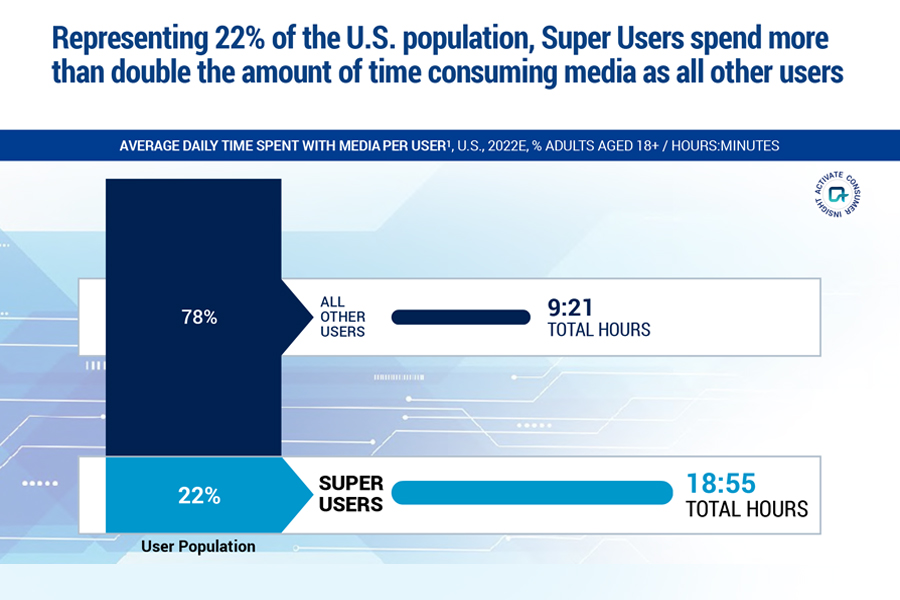
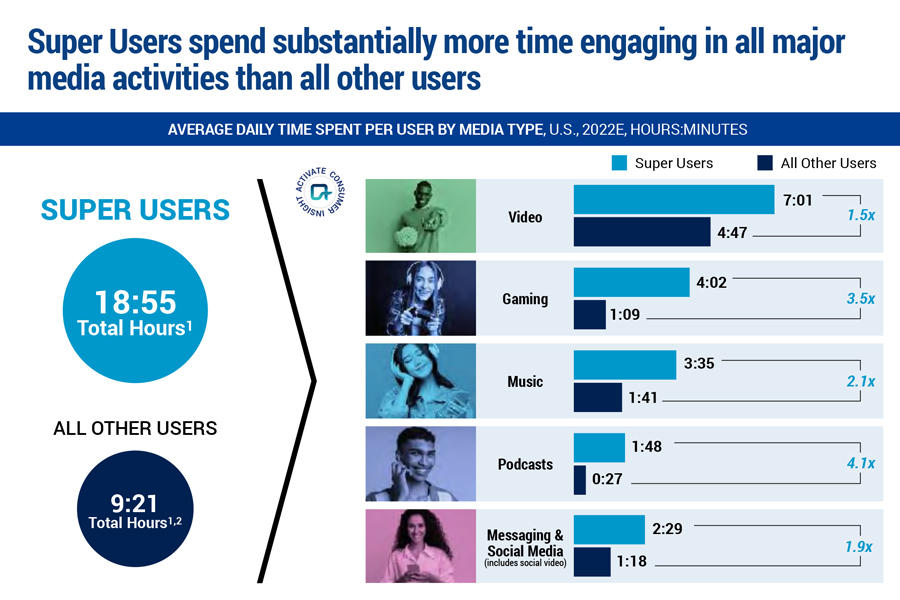
Inclined to multitask
Super Users take multitasking to the next level. Not only do they spend more time with electronics, but they excel in the art of juggling multiple activities. While watching videos and playing video games on one device, Super Users might also be busy engaging with social media on another. This makes them an unstoppable force when it comes to getting the most out of their digital experiences!

High share of dollar spend
Super Users are big spenders when it comes to media, particularly in gaming and music. Compared with all other users, Super Users’ average video spend is close to triple the amount ($76 vs $27). However, their biggest increases come from gaming and music; they’re collectively spending 12x more on games and shelling out 21x as much for tunes!
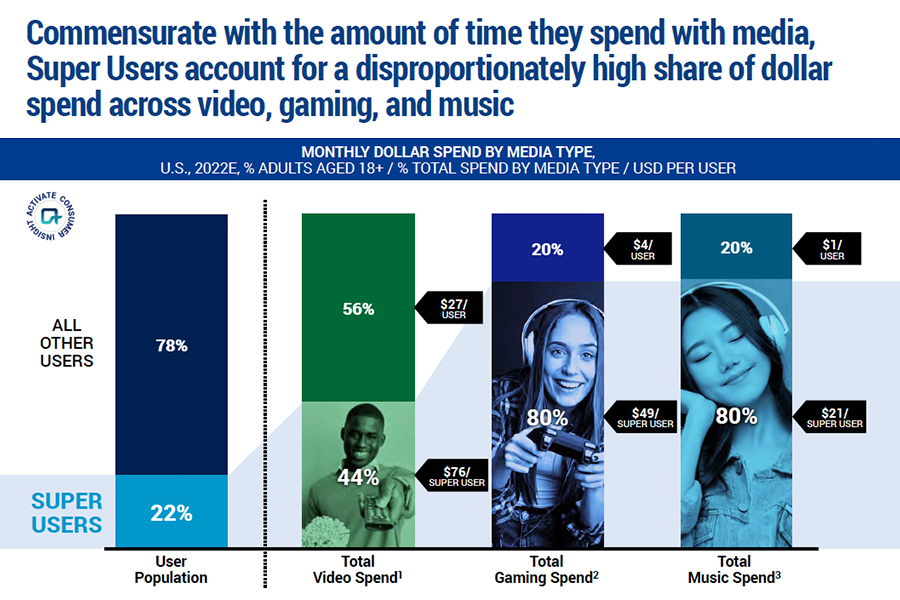
With 60% of eCommerce spend coming from Super Users, they are driving the industry forward with their enthusiasm and willingness to test out cutting-edge shopping trends like buying through social media, live streaming purchases, and trying on products virtually. Super Users are setting the tone for this dynamic industry.
Technology and media adoption
Most Super Users are brand advocates. They’re trendsetting individuals who stay ahead of the curve on media and technology. They eagerly take advantage of new products, services, and data-sharing opportunities to receive tailored ads that fit their lifestyle.
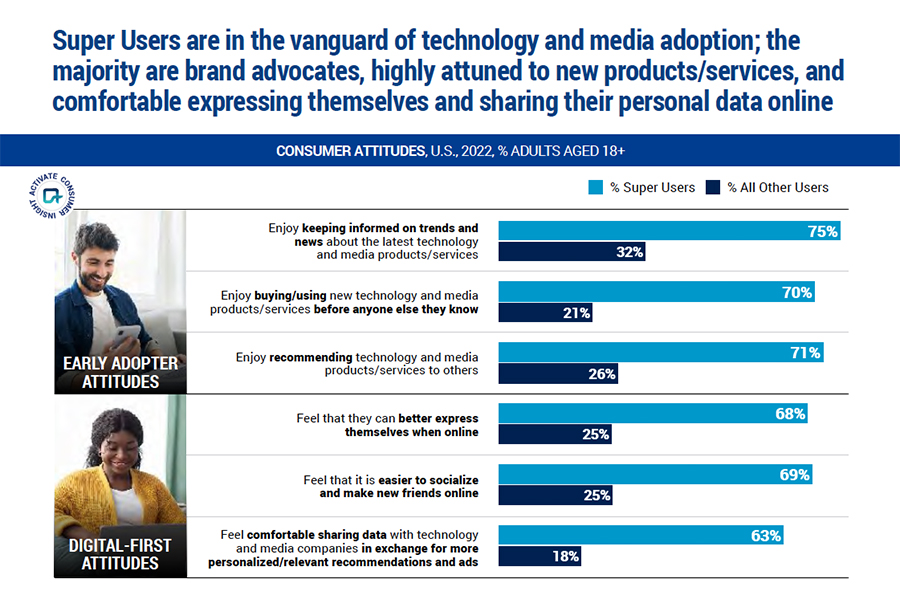
Crypto & NFTs
Super Users blaze the trail for cryptocurrency and non-fungible tokens (NFTs)! This group is five times more likely to explore, engage with, and embrace new digital-monetary technologies.
Pioneers of the Metaverse
As Metaverse usage continues to rise, Super Users are leading the way. Over 80% of these trailblazers have embraced these digital spaces within just the last year. We’re seeing accelerated interest from them as they seek out new opportunities for creativity, connections, and transactions within their favorite Metaverses. Many express interest in Metaverse experiences such as purchasing physical items to creating virtual havens. In fact, they’re 5x more interested in all things meta-related!
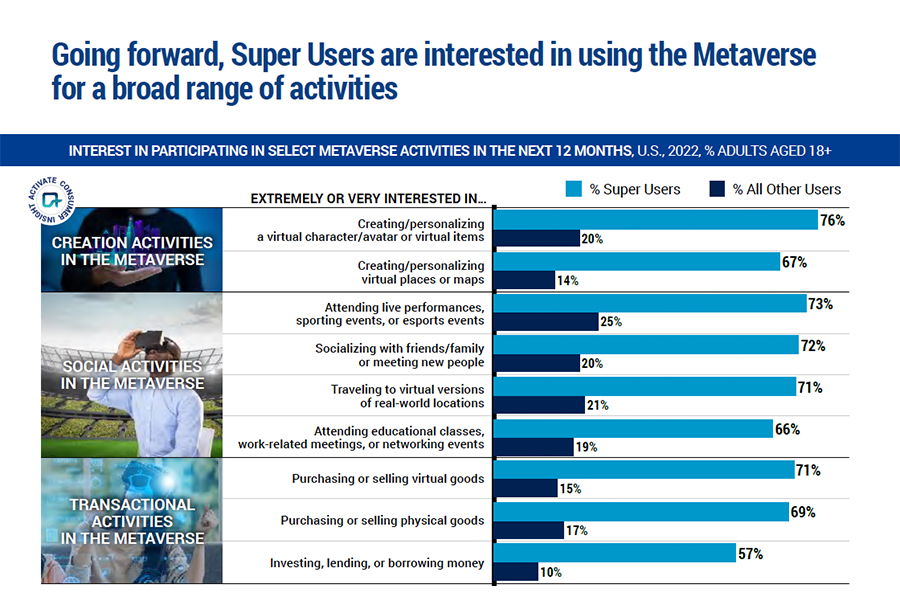
How Experian can help you identify and target Super Users
So how can you find your Super Users and include them in your marketing targeting strategy? Whether you want to build or acquire highly addressable audiences, we can help you precisely reach the right individuals and households in any channel you desire with Consumer View.
Consumer View
It all starts with data. Delivering the right message in the right place at the right time means truly knowing your prospects and customers as individuals – their lifestyles, behaviors, and shopping preferences. Consumer View data can provide a deeper understanding of your customers.
Consumer View is the world’s largest consumer database that contains over 3,900 attributes for 250 million adult consumers in the U.S. with coverage of 126 million (98%) of U.S. households. Consumer View can help you find out:
- What do your customers look like?
- What do your customers do?
- How and when should you reach your customers?
- What motivates your customers?
Modeled and syndicated audiences
We have over 2,500 pre-built audiences that are privacy-safe and built using advanced data science and the most comprehensive consumer data available. These digital audiences are readily available via major publishers, data management platforms (DMPs), advanced TV operators, and demand-side platforms (DSPs).
Our pre-built audiences can be used consistently across multiple distribution partners – making sure you can quickly find the right audience for the right campaign without having to build your own consumer personas. In addition to being available as digital audiences, our segmentation products are also available to use across all consumer touchpoints to enable consistent omnichannel campaign targeting.
There are infinite data combinations and selections we can help you with for optimal audience targeting. Using our comprehensive inventory of data, we can find even the most unusual of audiences to help you connect with new prospects. From demographics to behavioral and psychographic information, we draw on a massive base of knowledge accumulated during five decades in business.
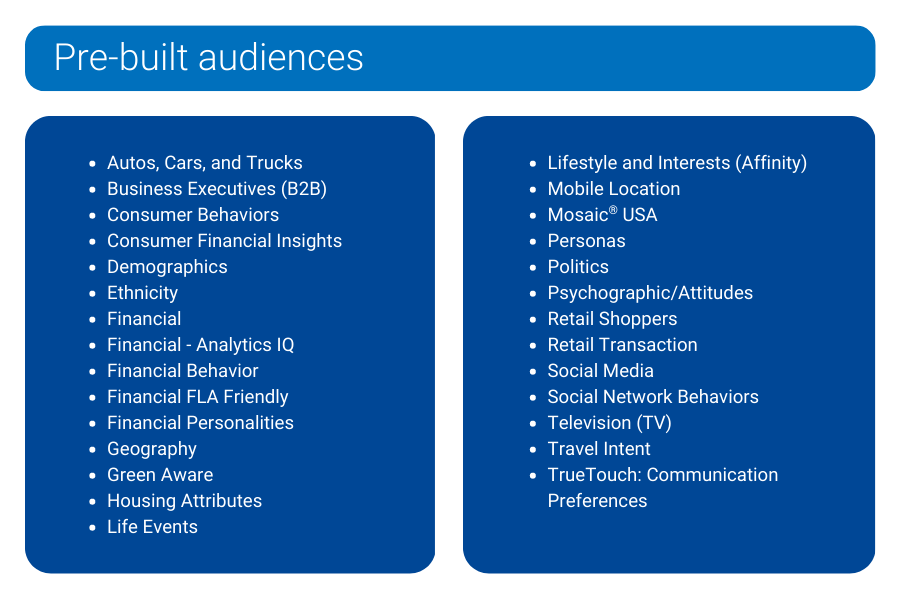
Mosaic® USA
Experian’s Mosaic® USA is a household-based consumer lifestyle segmentation system that classifies all U.S. households and neighborhoods into 71 unique types and 19 overarching groups, providing a 360-degree view of consumers’ choices, preferences, and habits. Using Mosaic lifestyle segmentation, you can anticipate the behavior, attitudes, and preferences of your best customers and reach them in the most effective traditional and digital channels with the right message in the right place at the right time.
Tailored Segmentation uses a sophisticated data-driven clustering system that leverages the 71 Mosaic types that match to first-party data like yours. Tailored Segmentation allows you to regroup Mosaic types based on the attributes you weigh as more impactful to your business. Have you designed your own segments in-house? You can apply Tailored Segmentation to those segments for deeper insights through a tailored analysis. Are you still looking for a way to segment your market even though you understand your typical best customer? Tailored Segmentation can weigh these attributes and develop a custom clustering and analysis of your market.
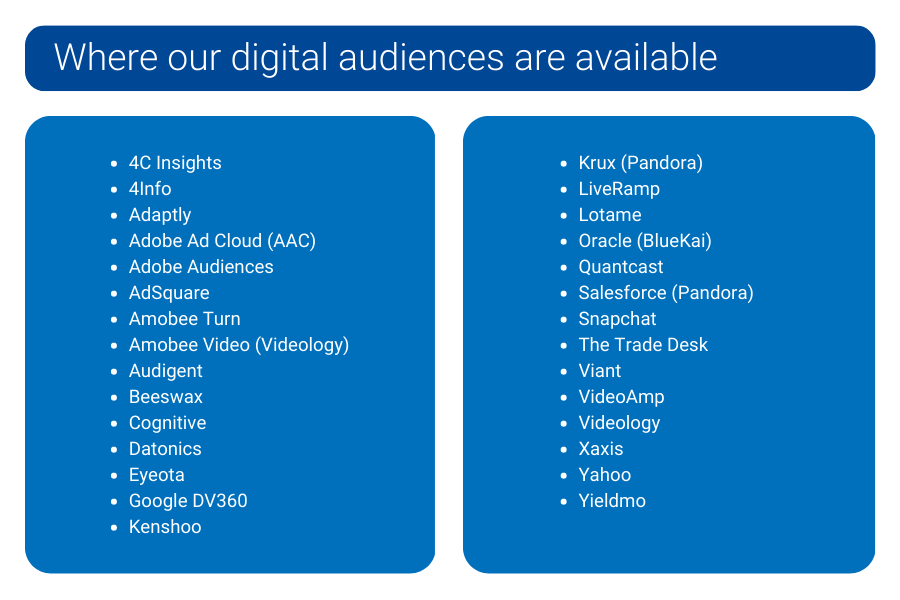
We can help you find your Super Users
Super Users are an important segment of any market. Marketers need to be able to identify them quickly and act upon their insights. Our marketing solutions provide the necessary data and analytical capabilities to easily find and target your potential Super Users for an effective marketing targeting strategy.
With Experian, you can deliver messages that are more in line with what matters to this influential group of customers. We understand how challenging it can be to find these customers and ensure they get the tailored, personalized messaging they deserve – so let us help you do just that! We can provide deep insights beyond the generic customer persona that allows marketers to look into the effectiveness of their marketing strategies from multiple angles. We want to help you gain an edge over your competitors by helping you identify, target, and engage Super Users for increased revenue growth. Ready to find your Super Users?
Sources
Activate Technology & Media Outlook 2023. Activate Consulting.
Latest posts

Published in AdExchanger. “Data-Driven Thinking" is written by members of the media community and contains fresh ideas on the digital revolution in media. Today’s column is written by Tom Manvydas, vice president of advertising strategy and solutions at Experian Marketing Services. The proliferation of connected electronics has spurred new interest in device-recognition technologies even though they have been in use since the 1990s. As we enter the “Internet of Things” era, device recognition will significantly impact the ad tech ecosystem. Many network advertising technologies are becoming obsolete as cookie blocking grows and the Internet becomes more mobile and device-centric. Device recognition will be yet another technology challenge for marketers but has the potential to overcome many key tracking, measurement and privacy issues with which data-driven marketers have struggled. By leveraging device recognition technologies, marketers can protect their investments in Web 2.0 ad tech, like multitouch attribution, and improve their overall digital marketing programs. Device Recognition Vs. Cookies Device recognition attempts to assign uniqueness to connected devices. By focusing on the device, you are able to “bridge” between browsers and apps, desktop to mobile and across OS platforms like iOS and Android. Device-recognition IDs function like desktop cookies for devices but with four important differences: 1. Coverage: Device-recognition methods are largely immune from cookie limitations. About half of mobile engagements on the Web do not involve cookies, while third-party blocking impacts up to 40% of desktop engagements. 2. Persistency: Device-recognition IDs can be more persistent and less fragmented than most desktop cookies. For example, Apple’s UDID or Android ID are permanent, and network node IDs like MAC addresses are near-permanent. Proxy IDs such as IDFA are persistent but can be updated by the device owner or ID provider. 3. Uniqueness: Devices are unique and cookies are fragmented. The digital media industry incurs substantial overhead cost and loss of efficiency when dealing with fragmented profiles and obsolete data caused by cookie churn. However, device-recognition methods are limited in their ability to recognize multiple profiles on shared devices. 4. Universality: Device-recognition technologies are universal and generally work across devices and networks. However, interoperability issues across device operating systems, such as iOS and Android, can limit the universal concept. There are many types of device-recognition technologies but two basic approaches to device recognition: deterministic and probabilistic, each with their pros and cons. Deterministic Approach: Accurate And Persistent But Complicated Deterministic device recognition primarily uses the collection of various IDs. While the mobile developer is familiar with the variety of IDs, it’s important that marketers become better-versed in this area. Examples include hardware IDs (including serial numbers), software-based device IDs (such as Apple’s UDID or the Android ID), digital data packet postal codes or proxy IDs (such as MAC addresses for WiFi or Bluetooth, IDFA for both iOS and Android and open-source IDs). Deterministic methods improve the accuracy of tracking, targeting and measurement over current cookie-based methods. They can improve the ability to more persistently manage consumer opt-outs. But the proliferation of device types limits the universality of deterministic device recognition. Without uniform standards across platforms, marketers need to account for multiple ID types. Also, deterministic device-recognition methods are not well developed for desktop marketing applications. The lack of interoperability across deterministic device IDs makes execution too complicated. Deterministic device IDs were meant for well-intentioned uses, such as tracking the carrier billing for a device. However, they present privacy and data rights challenges, leading to blocking or limited access by companies that control IDs. Probabilistic Device Recognition: A ‘Goldilocks’ Solution Probabilistic device recognition may be the ideal solution for a connected world that does not rely on cookies nor wants to use overly intrusive deterministic device recognition. Probabilistic device recognition is not a replacement for deterministic IDs. Instead, it complements their function and provides coverage when they are not available. The probabilistic approach is based on a statistical probability of uniqueness for any single device profile. This approach creates a unique profile based on a large number of common parameters, such as screen resolution, device type and operating system. This process can uniquely identify a device profile with 60% to 90% accuracy, compared to 20% to 85% accuracy for cookie-based identification methods. Probabilistic IDs are more persistent than cookies with better coverage, but less persistent than deterministic device IDs. The natural evolution of the device takes place over time and prevents persistent identification. Probabilistic device recognition can be universal and is not impacted by interoperability issues across platforms — the technology used to generate a probabilistic ID on one network can be the same technology on another network. Unlike some deterministic device recognition approaches, there is no device fingerprinting. Probabilistic device recognition accurately identifies profiles in aggregate, rather than a single device. That’s the inherent beauty of probabilistic device recognition: It can generate more accurate targeting results than cookie-based methods without explicitly identifying single devices. This is more than good enough for most marketers and significantly better than what’s available today. Another benefit is the absence of any residue on the device — no cookie files, flash files or hidden markers. Probabilistic methods can work on devices that block third-party cookies or connect to the Web without using any cookies. For example, you might have a hard-to-reach but valuable audience segment. Probabilistic device recognition could effectively increase your reach on this segment by 40% to 50% and increase the overall targeting accuracy by two times. Let’s say the actual population for this segment is 100,000 members. The typical cookie-based approach might reach 28,000 members but the typical probabilistic device-recognition approach could reach 65,000 members. A Decline In Hardware Entropy If you take a close look at the emitted data from today’s devices, it is not easy to analyze it for device identification. That’s because the data footprint of one device looks a lot like another. Device recognition augmentation methods can address this, such as device usage profiles, geo location clustering, cross-device/screen analytics or ID linkage for first-party data owners. In the short term, device-recognition technologies, particularly probabilistic methods, can greatly improve today’s digital marketing programs. Marketers should become fluent in their use cases and benefits. If 2013 was the year of mobile, I think we’ll see a surge in marketing applications based on device-recognition technologies in 2014. Follow Experian Marketing Services (@ExperianMkt) and AdExchanger (@adexchanger) on Twitter.

According to Experian Marketing Services’ 2014 Digital Marketer: Benchmark and Trend Report, social media Websites are playing an increasingly important role in driving traffic to other Websites, including retail sites and even other social networking sites, at the expense of search engines and portal pages. For instance, as of March 2014, social media sites account for 7.72 percent of all traffic to retail Websites, up from 6.59 percent in March 2013. Further, Pinterest, more than Facebook or YouTube, is supplying the greatest percentage of downstream traffic to retail sites. According to the Digital Marketer Report, more retailers are directing their customers to social media within their email campaigns. In fact, 96 percent of marketers now promote social media in their emails, and it shows. In 2013, for instance, email Websites generated 18 percent more clicks to social networking pages than the year prior. Social drives more traffic to other social Websites Social media Websites are driving more and more traffic to other social sites. In 2013, 15.1 percent of clicks to social networking and forum sites came from other social networking sites, up from a 12.5 percent click share reported in 2012. Despite driving the greatest share of traffic to social networking sites with 39.1 percent of clicks, search engines’ share of upstream traffic to social declined a relative 13 percent year-over-year. Among the other top referring industries to social, only the portal front pages industry — which includes sites like Yahoo!, MSN and AOL and is closely affiliated with search engines — showed a drop in upstream click share providing further evidence that increasingly all (or most) roads lead to social. To learn more about key trends in social media traffic, including downstream traffic from social sites and the share of consumers accessing social media across multiple channels, download the free 2014 Digital Marketer: Benchmark and Trend Report.

Mother’s Day may not exactly be right around the corner, but the time to send your Mother’s Day emails sure is! Based on our analysis of 186 brands that sent Mother’s Day mailings in 2013, 75 percent of email volume and 80 percent of email-generated revenue occurred between May 1st and Mother’s Day (May 12, 2013). The highest revenue-producing days were five days before the holiday (Wednesday, May 8, 2013) and Mother’s Day itself. This year, the sentimental holiday falls one day sooner than last year (May 11), but you still have more than enough time consider these quick tips for easy wins while planning and executing your campaigns. Tip 1: Give them what they’re searching for Last year, online searches five weeks before Mother’s Day were dominated by searches for the date of the holiday. As such, we recommend including the date of Mother’s Day in your email subject lines, particularly those early in the season, when customers are searching online for, and opening emails with, that information. Tip 2: Set the tone early with your subject lines A sample of early season subject lines that outperformed the overall unique open rate included: Remember Mom on Mother’s Day, May 12 Get a head start on Mother’s Day (plus a gift for you) Just arrived: Mother’s Day Gift Sets To Mother, With Love Tip 3: When it comes to timing, it’s the thought that counts Think through the timing of your emails depending on order delivery deadlines. On May 8th of last year, the largest revenue producers for email were orders for flowers and gifts placed in time to be delivered by Mother’s Day. Email subject lines on May 8th included reminders of the delivery deadlines: Last Chance: Free Shipping/No Service Charge for Mother’s Day! ENDS TODAY: Enjoy Complimentary Second Day Delivery in Time for Mother’s Day Tip 4: Let them treat themselves On Mother’s Day, the top email revenue generators were “self-gifting” (treat yourself on Mother’s Day only), Mother’s Day online sales and free shipping, as well as e-gift cards: Free Shipping Today Only! Happy Mother’s Day You deserve a treat yourself! HAPPY MOTHER’S DAY! Treat yourself to 30% off today only Last Chance: eGift Cards in Time for Mother’s Day Other email performance highlights: Note: All email performance highlights are based on comparisons to Mother’s Day mailings without the highlighted feature from matched brands. To all those in the midst of Mother’s Day campaign planning, good luck and happy sending!